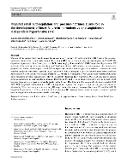Impaired renal autoregulation and pressure-natriuresis: any role in the development of heart failure in normotensive and angiotensin II-dependent hypertensive rats?

Author
Honetschlägerová, Zuzana
Sadowski, Janusz
Kompanowska-Jezierska, Elzbieta
Publication date
2023Published in
Hypertension ResearchVolume / Issue
46 (9)ISBN / ISSN
ISSN: 0916-9636Metadata
Show full item recordCollections
This publication has a published version with DOI 10.1038/s41440-023-01401-z
Abstract
The aim of the present study was to assess the autoregulatory capacity of renal blood flow (RBF) and of the pressure-natriuresis characteristics in the early phase of heart failure (HF) in rats, normotensive and with angiotensin II (ANG II)-dependent hypertension. Ren-2 transgenic rats (TGR) were employed as a model of ANG II-dependent hypertension. HF was induced by creating the aorto-caval fistula (ACF). One week after ACF creation or sham-operation, the animals were prepared for studies evaluating in vivo RBF autoregulatory capacity and the pressure-natriuresis characteristics after stepwise changes in renal arterial pressure (RAP) induced by aortic clamping. In ACF TGR the basal mean arterial pressure, RBF, urine flow (UF), and absolute sodium excretion (U(Na)V) were all significantly lower tha n in sham-operated TGR. In the latter, reductions in renal arterial pressure (RAP) significantly decreased RBF whereas in ACF TGR they did not change. Stepwise reductions in RAP resulted in marked decreases in UF and U(Na)V in sham-operated as well as in ACF TGR, however, these decreases were significantly greater in the former. Our data show that compared with sham-operated TGR, ACF TGR displayed well-maintained RBF autoregulatory capacity and improved slope of the pressure-natriuresis relationship. Thus, even though in the very early HF stage renal dysfunction was demonstrable, in the HF model of ANG II-dependent hypertensive rat such dysfunction and the subsequent HF decompensation cannot be simply ascribed to impaired renal autoregulation and pressure-natriuresis relationship.
Keywords
Ren-2 transgenic hypertensive rat, Renal autoregulation, Renal blood flow, Sodium excretion, Volume-overload heart failure
Permanent link
https://hdl.handle.net/20.500.14178/2177License
Full text of this result is licensed under: Creative Commons Uveďte původ 4.0 International







